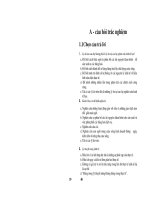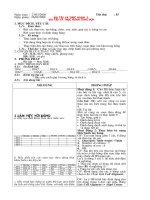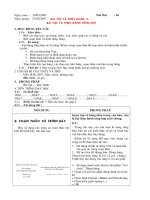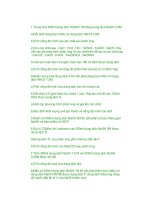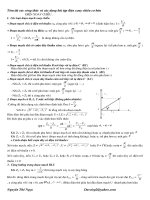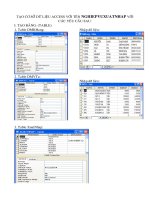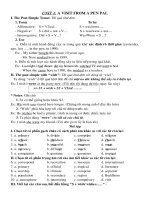BT math1
Bạn đang xem bản rút gọn của tài liệu. Xem và tải ngay bản đầy đủ của tài liệu tại đây (175.84 KB, 7 trang )
Hanoi University of Science and Technology
Dr. Bui Xuan Dieu
School of Applied Mathematics and Informatics
ICT
Math1 Exercises
1
Symbolic Logic
Exercise 1.1. Show that the following propositions are tautology
a) [(A → B) ∧ (B → C)] → (A → C).
Exercise 1.2. Which of the following propositions are tautology, contradiction
a) (p ∨ q) → (p ∧ q),
d) q → (q → p),
b) (p ∧ q) ∨ (p → q),
e) (p → q) → q,
c) p → (q → p),
f) (p ∧ q) ↔ (q
p).
Exercise 1.3. Prove that
a) A ↔ B and (A ∧ B) ∨ (A ∧ B) are logically equivalent.
b) (A → B) → C and A → (B → C) are not logically equivalent.
Exercise 1.4. Find the negation p if
a) p = ”∀ > 0, ∃δ > 0 : ∀x, |x − x0 | < δ, |f (x) − f (x0 )| < .”
b) p = lim xn = ∞ ⇔ ∀M > 0, ∃N ∈ N : ∀n ≥ N, |xn | > M.
n→+∞
c) p = lim xn = L ⇔ ∀ > 0, ∃N ∈ N : ∀n ≥ N, |xn − L| < .
n→+∞
2
Sets
Exercise 2.1. Let
A = {x ∈ R|x2 − 4x + 3 ≤ 0}, B = {x ∈ R||x − 1| ≤ 1},
and
C = {x ∈ R|x2 − 5x + 6 ≤ 0}.
Compute (A ∪ B) ∩ C and (A ∩ B) ∪ C.
Exercise 2.2. Let A, B, C be arbitrary sets. Prove that
a) A ∩ (B \ C) = (A ∩ B) \ (A ∩ C).
b) A ∪ (B \ A) = A ∪ B.
c) If (A ∩ C) ⊂ (A ∩ B) and (A ∪ C) ⊂ (A ∪ B), then C.
1
d) A \ (A \ B) = A ∩ B.
e) (A \ B) ∪ (B \ A) = (A ∪ B) \ (A ∩ B).
f) (A ∪ B) × C = (A × C) ∪ (B × C).
g) (A ∩ B) × C = (A × C) ∩ (B × C).
h) Is it true that (A ∪ B) × (C ∪ D) = (A × C) ∪ (B × D). If not, give a counterexample.
Exercise 2.3. Let A be a set with n elements. Determine the total number of subsets of A.
Exercise 2.4. How many numbers are not divisible by 3, 4, 5 between 1 and 1500?
3
Maps
Exercise 3.1. Let f : X → Y . Prove that
a f (A ∪ B) = f (A) ∪ f (B), A, B ⊂ X
b f (A ∩ B) ⊂ f (A) ∩ f (B), A, B ⊂ X. Give an example to show that the converse is not true.
c f is injective if and only if for any A, B ⊂ X, f (A ∩ B) = f (A) ∩ f (B).
d f −1 (A ∪ B) = f −1 (A) ∪ f −1 (B), A, B ⊂ Y
e f −1 (A ∩ B) = f −1 (A) ∩ f −1 (B), A, B ⊂ Y
f f −1 (A \ B) = f −1 (A) \ f −1 (B), A, B ⊂ Y
g A ⊂ f −1 (f (A)), A ⊂ X,
h B ⊃ f (f −1 (B)), B ⊂ Y .
Exercise 3.2. Let f : R2 → R2 , f (x, y) = (2x, 2y) and A = {(x, y) ∈ R2 |(x − 4)2 + y 2 = 4}. Find
f (A), f −1 (A).
Exercise 3.3. Which of the following maps are injective, surjective, bijective?
a) f : R → R, f (x) = 3 − 2x,
b) f : (−∞, 0] → [4, +∞), f (x) = x2 + 4,
c) f : (1, +∞) → (−1, +∞), f (x) = x2 − 2x,
d) f : R \ {1} → R \ {3}, f (x) =
3x+1
x−1 ,
e) f : [4, 9] → [21, 96], f (x) = x2 + 2x − 3,
f) f : R → Rf (x) = 3x − 2|x|,
1+x
g) f : (−1, 1) → R, f (x) = ln 1−x
,
2
h) f : R \ {0} → R, f (x) = x1 ,
i) f : R → R, g(x) =
2x
1+x2 .
Exercise 3.4. Let f (x) = −x2 − 2x + 3.
a) Find a such that f : R → (−∞, a] is surjective.
b) Find b such that f : [b, +∞) → (−∞, 3] is injective.
Exercise 3.5. Let X, Y, Z be sets and f : X → Y,
g : Y → Z. Prove that
a) if f is surjective and g ◦ f is injective, then g is injective,
b) give an example to show that g ◦ f is injective, but g is not,
c) if g is is injective and g ◦ f is surjective, then f is surjective,
d) give an example to show that g ◦ f is surjective but f is not.
Exercise 3.6. Let f : X → Y be a map. Prove that
a) f is surjective iff there exists g : Y → X such that f ◦ g = IdY ,
b) f is injective iff there exists g : Y → X such that f ◦ g = IdX .
Exercise 3.7. Let X be a set such that card X = n. Find the total number of bijective from X to itself.
Exercise 3.8. Let X, Y be sets such that card X = m, card Y = n. Find the total number of maps from
X to Y .
Exercise 3.9. Let X, Y be sets such that card X = m, card Y = n and m < n. Find the total number of
injective from X to Y .
Exercise 3.10. Let
1
σ=
3
and
1
τ =
3
2
3
4
5
6
7
8
9
10
4
2
1
5
7
6
9
10
8
2
3
4
5
6
7
8
9
10
4
1
2
5
7
6
9
8
10
,
i) Compute σ −1 and τ ◦ σ.
ii) Write σ, τ as a product of disjoint cycles.
iii) Compute sign(σ), sign(τ ).
Exercise 3.11. Let |X| = n and f be a bijection from X to X. Prove that there exists k ∈ N such that
f k = IdX , where f k = f ◦ f · · · ◦ f (k-times).
3
4
Binary relations
Exercise 4.1. Let X be a set and P (X) be the collection of all subsets of X. We define a relation ≤ on
P (X) as follow: A ≤ B ⇔ A ⊂ B.
a) Prove that this is an order relation on P (X).
b) Is it a total order relation?
c) Find the maximal and minimal element of P (X).
Exercise 4.2. Let ≤ be an order relation on X. Prove the following statements.
a) The greatest element, if exists, is unique.
b) The least element, if exists, is unique.
c) Find an example of (X, ≤) such that the greatest (least) element does not exist.
d) If x is the greatest (least) element, then x is also a maximal (minimal) element.
e) In totally ordered set, the terms maximal element and greatest element coincide.
Exercise 4.3. Let A, B be sets and ≤ be a total order relation on B. Assume that f : A → B is a map.
We define a relation on A as follow:
a1
a) Prove that if f is injective, then
b) Give an example to show that
a2 ⇔ f (a1 ) ≤ f (a2 ).
is an order relation on A.
is not an order relation on A.
Exercise 4.4. Let S be an order relation on X × X. The inverse relation of S, denoted by S −1 , defined
by xS −1 y ⇔ ySx. Prove that S −1 is an order relation.
Exercise 4.5. Let X = N × N, where N is the set of natural numbers. Consider a relation ∼ on X as
follow (a, b) ∼ (c, d) ⇔ a + d = b + c. Prove that ∼ is an equivalent relation.
Exercise 4.6. Let Z be the set of integers, Z∗ = Z \ {0} and X = Z × Z ∗ . Consider a relation on X as
follow (a, b) ∼ (c, d) ⇔ ad = bc. Prove that this is an equivalent relation.
Exercise 4.7. Let S be an order relation on X × X. The inverse relation of S, denoted by S −1 , defined
by xS −1 y ⇔ ySx. Prove that S −1 is an order relation.
Exercise 4.8. Let R1 , R2 be relations on Z defined as follow
xR1 y if x + y is an odd number,
xR2 y if x + y is an even number
Determine whether R1 , R2 are order or equivalence relations?
4
Exercise 4.9. Consider the relations R1 , R2 on R2 as follow
(x1 , x2 )R1 (y1 , y2 ) ⇔ x21 + x22 = y12 + y22 ,
(x1 , x2 )R2 (y1 , y2 ) ⇔ x11 + x22 ≤ y12 + y22 .
Determine whether R1 , R2 are order or equivalence relations?
Exercise 4.10. Consider the commutativity, associativity of the following binary operator ∗ on R and ◦
on R2 and find the identity element, the inverse element.
a) x ∗ y := xy + 1,
b) x ∗ y := 12 xy,
c) x ∗ y := |x|y .
d) (x1 , x2 ) ◦ (y1 , y2 ) :=
x1 +y1 x2 +y2
2 ,
2
.
Exercise 4.11. Let X, Y be sets, ∗ : Y × Y → Y is a commutative, associative binary operator with
identity element e and f : X → Y be an bijection. Consider the binary operator on X as follow: x1 ◦ x2 =
f −1 (f (x1 ) ∗ f (x2 )). Prove that ◦ is a commutative, associative binary operator with identity element.
Exercise 4.12. Which of the following are groups?
a) (Z, +), (Q, +), (R, +), (N, +), (Z/n, +)..
b) (Z∗ = {±1}, ×), (Q∗ = Q \ {0}, ×), (R∗ , ×).
c) (Sn , ◦), where Sn is the set of all permutations on n elements.
d) (mZ, +), where mZ = {n ∈ Z|n is divisible by m}.
e) (2Z , ×), where 2Z = {2n , n ∈ Z}.
f) (Pn (X), +), where Pn (X) is the all real polynomials of degree not exceeding n.
Exercise 4.13. Let X be arbitrary set and consider the binary operator x ∗ y = x, ∀x, y ∈ X. Prove that
(X, ∗) is a semigroup.
Exercise 4.14. Lett X be a semigroup with the multiplication.
a) Prove that if ab = ba∀a, b ∈ X, then (ab)n = an bn , n > 1.
b) Let a, b ∈ X such that (ab)2 = a2 b2 . Can we conclude that ab = ba?
Exercise 4.15. Prove that
a) (Z, +, ×), (Q, +, ×) are commutative rings with identity.
b) (N, +, ×) is not a ring.
5
c) (Z/n, +, ×) is a commutative ring with identity.
1
√
√
Exercise 4.16. Let X = {a + b 2|a, b ∈ Z} and Y = {a + b 2|a, b ∈ Q}. Are X, Y rings with addition
and multiplication?
√
√
√
(a + b 2) + (c + d 2) = (a + c) + (b + d) 2,
√
√
√
(a + b 2)(c + d 2) = (ac + 2bd) + (ad + bc) 2,
Exercise 4.17. Prove that
a) (Q, +, ×) is a field.
b) The ring (Z, +, ×) is not a field.
√
√
Exercise 4.18. Let X = {a + b 2|a, b ∈ Z} and Y = {a + b 2|a, b ∈ Q}. Are X, Y fields with addition
and multiplication?
√
√
√
(a + b 2) + (c + d 2) = (a + c) + (b + d) 2,
√
√
√
(a + b 2)(c + d 2) = (ac + 2bd) + (ad + bc) 2,
Exercise 4.19. Find GCD(3195, 630), GCD(1243, 3124), GCD(123456789, 987654321)
Exercise 4.20. Find integers a, b such that 1243a + 3124b = 11.
Exercise 4.21. Presentation the following numbers by the base 6:
a) 2011,
b) 3125.
Exercise 4.22. Perform the following operations
a) 3145(7) + 5436(7) ,
c) 3142(7) : 6(7) ,
b) 6145(7) − 5451(7) ,
d) 3142(7) × 54(7) .
1
2
3
4
5
6
1
1
2
3
4
5
6
2
2
4
6
11
13
15
3
3
6
12
15
21
24
4
4
11
15
22
26
33
5
5
13
21
26
34
42
6 6 15 24 33 42 51
The multiplication table with base 7
Exercise 4.23. Write the following complex numbers in the canonical form.
1 it
is called the multiplicative group of integers modulo n.
6
√
a) (1 + i 3)9 ,
b)
8
c)
√
1 − i 3,
(1+i)21
(1−i)13 ,
√
√
d) (2 + i 12)5 ( 3 − i)11 .
Exercise 4.24. Solve the following equations
a) z 2 + z + 1 = 0,
d) z 6 − 7z 3 − 8 = 0,
b) z 2 + 2iz − 5 = 0,
e)
c) z 4 − 3iz 2 + 4 = 0,
√
f) z 8 ( 3 + i) = 1 − i.
Exercise 4.25. Prove that if z +
Exercise 4.26.
1
z
= 2 cos ϕ, then z n +
(z+i)4
(z−i)4
1
zn
= 1,
= 2 cos nϕ, ∀n ∈ N.
a) Find the sum of n-roots of the complex number 1.
b) Find the sum of n-roots of an arbitrary complex number z = 0.
c) Let
k
2kπ
= cos 2kπ
n + i sin n , k = 0, 1, . . . , n − 1. Compute S =
Exercise 4.27. Consider the equation
(z+1)9 −1
z
n−1
k=0
m
k ,
(m ∈ N).
= 0.
a) Solve the above equation.
b) Compute the moduli of the solutions.
8
c) Compute the product of its solutions and
k=1
sin kπ
9 .
Exercise 4.28. Solve the following equation
a) z 7 =
1
z3 ,
b) z 4 = z + z.
Exercise 4.29. Let x, y, z be complex numbers that satisfy |x| = |y| = |z| = 1. Compare the modulus of
x + y + z and xy + yz + zx.
7
